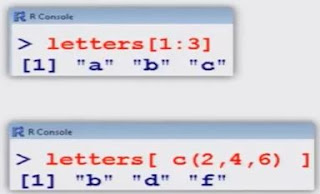A vector of positive integers (letters, and Letters return the 26 lowercase and uppercase letters, respectively).

> letters [1 : 3]
[1] "a" "b" "c"
> letters [c(2,4,6) ]
[1] "b" "d" "f'"
> LETTERS [1 : 3]
[1] "A" "B" "C"
> LETTERS [ c(2,4,6) ]
[1] "B" "D" "E"
> letters
[1] "a" "b" "c" "d" "e" "f" "g" "h" "i" "j" "k" "l" "m"
[14] "n" "o" "p" "q" "r" "s" "t" "u" "v" "w" "x" "y" "z"
>
> LETTERS
[1] "A" "B" "C" "D" "E" "F" "G" "H" "I" "J" "K" "L" "M"
[14] "N" "O" "P" "Q" "R" "S" "T" "U" "V" "W" "X" "Y" "Z"
>
> letters [1]
[1] "a"
>
> letters [14]
[1] "n"
> Letters [1]
[1] "A"
> LETTERS [14]
[1] "N"
> letters [c(12,20,26) ]
[1] "1" "t" "z"
String vector
→ The elements of a vector can be named.
Using these names, we can access the vector elements.
names is used for functions to get or set the names of an object.
> z <- list (al = 1, a2 = "c" , a3 = 1 :3)
> z
$al
[1] 1
$a2
[1] "c"
$a3
[1] 1 2 3
> names (z)
[1] "a1" "a2" "a3"
Matrices created from Lists
List can be heterogeneous (mixed modes).
We can start with a heterogeneous list, give it dimensions, and thus create a heterogeneous matrix that is a mixture of numeric and character data:
Example
> ab <- list (1, 2, 3, "x", "y" , "z")
> dim(ab) <- c(2,3)
> print(ab)
[,1] [,2] [,3]
[1,] 1 3 "y"
[2,] 2 "x" "z"

> letters [1 : 3]
[1] "a" "b" "c"
> letters [c(2,4,6) ]
[1] "b" "d" "f'"
> LETTERS [1 : 3]
[1] "A" "B" "C"
> LETTERS [ c(2,4,6) ]
[1] "B" "D" "E"
> letters
[1] "a" "b" "c" "d" "e" "f" "g" "h" "i" "j" "k" "l" "m"
[14] "n" "o" "p" "q" "r" "s" "t" "u" "v" "w" "x" "y" "z"
>
> LETTERS
[1] "A" "B" "C" "D" "E" "F" "G" "H" "I" "J" "K" "L" "M"
[14] "N" "O" "P" "Q" "R" "S" "T" "U" "V" "W" "X" "Y" "Z"
>
> letters [1]
[1] "a"
>
> letters [14]
[1] "n"
> Letters [1]
[1] "A"
> LETTERS [14]
[1] "N"
> letters [c(12,20,26) ]
[1] "1" "t" "z"
String vector
→ The elements of a vector can be named.
Using these names, we can access the vector elements.
names is used for functions to get or set the names of an object.
> z <- list (al = 1, a2 = "c" , a3 = 1 :3)
> z
$al
[1] 1
$a2
[1] "c"
$a3
[1] 1 2 3
> names (z)
[1] "a1" "a2" "a3"
Matrices created from Lists
List can be heterogeneous (mixed modes).
We can start with a heterogeneous list, give it dimensions, and thus create a heterogeneous matrix that is a mixture of numeric and character data:
Example
> ab <- list (1, 2, 3, "x", "y" , "z")
> dim(ab) <- c(2,3)
> print(ab)
[,1] [,2] [,3]
[1,] 1 3 "y"
[2,] 2 "x" "z"




.png)
.png)



















.png)




.png)












0 Comments:
Post a Comment